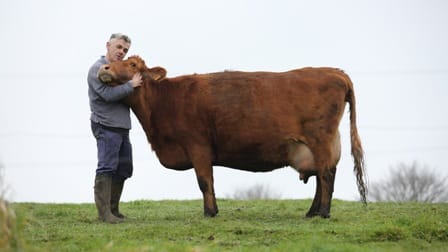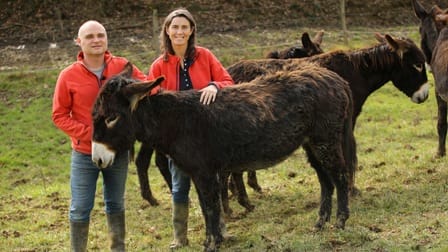Libourne, 28 February 2018– At the International Agriculture Show, Ceva Santé Animale and the Fondation du Patrimoine awarded the Fondation du Patrimoine National Animal Agrobiodiversity Prize to three breeders committed to the preservation of animal breeds in danger of extinction. The first prize of €10,000 went to Froment du Léon cattle from Côtes-d’Armor; second prize of €6,000 went to Bordelaise cattle from Gironde; and third prize of €4,000 went to the Pyrenee donkey, from Gers.
Animal biodiversity: a major challenge for the agriculture of tomorrow
Co-founded in 2012 by the Fondation du Patrimoine and Ceva Santé Animale, with the support of a private sponsor and the patronage of the French Ministry for Agriculture and Food, the ‘Fondation du Patrimoine National Animal Agrobiodiversity Prize’ highlights rare French breeds that represent a unique genetic heritage: cattle, goats, horses, sheep, pigs, working dogs and other farmyard animals.
The jury’s decisions were based on three main criteria: the economic dimension of the project, its social and environmental impact in its locality, and the efforts made to raise awareness of and communicate around the rare breeds (list of 2018 jury members). Since it was established, the prize has promoted more than 170 French regional initiatives and recognised 16 livestock owners.
Today, in France, more than 80% of regional agricultural breeds are considered under threat of extinction.[1] This would be highly detrimental, given their contribution not only to the identity and economic equilibrium of their regions but also to maintaining the diversity required to preserve our eco-system. The more diverse the latter is, the better it will be able to cope with the emerging climatic change and health issues.
However, according to a survey by Ceva Santé Animale and the Fondation du Patrimoine,[2] just 20% of French people are aware of the threat hanging over traditional breeds. 35% do not know or do not think that local agricultural breeds are in danger (45% think only certain species are under threat). On the other hand, 83% of French people say they would be prepared to pay more for cheese or meat if it helped support traditional breeds.
These figures underline the importance of this commitment to French farmers – the key stakeholders in the agriculture of the future.
Dr Marc Prikazsky, CEO of Ceva Santé Animale, explains: “One of the main functions of agriculture is to feed the world’s population – in terms of not just quantity but also quality. That’s a big ask, and it requires us to develop practices that can adapt to the extraordinary diversity of economic, social and cultural realities. Our vision, as a veterinary company, is to support all forms of agriculture, paying particular attention to animal welfare, which has to be the common thread running through agriculture and all efforts to preserve agricultural biodiversity – a major block in the preservation of our ecosystem. These are two reasons why we are here today, standing shoulder to shoulder with the Fondation du Patrimoine and the farmers working hard to ensure the continuation of our regional animal breeds.”
Adds Célia Verot, Director-General of the Fondation du Patrimoine: “It is the Fondation du Patrimoine’s mission to safeguard our cultural as well as our natural heritage. Let us ensure there is no conflict between nature and culture, between biodiversity and human activity. In the countryside, our local agricultural breeds have shaped the landscape and continue, today, to preserve it. They have a rich and unique genetic heritage. We are proud to be able, through awarding this prize, to support those breeders working hard to keep this heritage alive for all of us.”
[1] Cattle, sheep, goats, pigs, horses, donkeys, chickens, turkeys geese, ducks – source: a study by the French National Institute for Agricultural Research (INRA), entitled ‘Races menacées’ (‘Breeds under threat’), 11-2014
[2] Acknowledgement: survey carried out on behalf of Ceva by Opinea – ‘The French and animal biodiversity’, July 2017
Spotlight is on cattle and horse breeds in this 6th edition of the prize
1st PRIZE: FROMENT DU LEON CATTLE (Côtes-d’Armor) Brittany
Endowment: €10 000
Project leaders: Maëve and Stéphane Terlet, breeders
Town: 22480 Lanrivain
Known as the ‘vache à madame’ (gentle cow) on account of its pleasant nature, or the ‘vache des châteaux’ (castle cow), owing to its popularity among the erstwhile nobility for its high-quality milk, the Froment du Léon is a very rare breed, found mainly in the Côtes-d’Armor region. Having practically disappeared in the wake of the Second World War, because of a focus on more lucrative breeds, their numbers remain low, at a total of just under 400 cows in 2017.
The jury wanted to reward the candidate couple, Maëve and Stéphane Terlet, for their courage and tenacity in saving this cattle breed by promoting their milk in the form of superior-quality butter. The aim of this top prize is to encourage all breeders of these cattle to see that they have a real advantage to offer right now, when people are actively seeking out quality and regional products.
2nd PRIZE: BORDELAISE CATTLE (GIRONDE) NOUVELLE-AQUITAINE
Endowment: €6 000
Project leader: Christophe Guénon, breeder
Town: 33850 Léognan
In the 19th and 20th centuries, the large towns of the south-west of France were supplied with butter, cream and milk by the Bordelaise cow. This economic function was overtaken by more productive breeds, which, alongside an epizootic outbreak in 1870, all but wiped the breed out. A few cows were rediscovered in the 1980s, which meant they could start being bred again. A quarter of a century later, there are fewer than 200 head of Bordelaise cattle left.
The jury was impressed by several elements: Christophe Guénon’s farming methods, which enabled breeding to be reintroduced on agricultural land that had been abandoned (eco-pasture on a Natura 2000-classified site), and the work carried out in partnership with the Conservatoire des Races d’Aquitaine (body that protects rare breeds originating from the Aquitaine region), based on protecting valuable genetic heritage and promoting the breed via milk and meat production.
3rd PRIZE: PYRENEES DONKEY (GERS) OCCITANIE
Endowment: €4 000
Project leaders : Cécile and Emmanuel Guichard, breeders
Town: 32350 Biran
A strong and sturdy animal, the Pyrenean donkey was renowned in the 19th century for producing mules well suited to agricultural work. Although common up to the early part of the 20th century, they saw their numbers dwindle with the arrival of the motor vehicle in the countryside. Officially recognised in 1997, the breed comprises two types: the Gascon type, which stands between 1.2m and 1.35m tall, and the leaner Catalan type, which stands at 1.35m tall. In 2016, 75 animals were registered.
The jury praised Cécile and Emmanuel Guichard’s initiative in choosing to turn Hitton farm into a place for the preservation of the Pyrenees donkey breed. To this end, they had the original economic idea of using the milk of the jennies to manufacture organic cosmetic products on the farm.
>> PDF version available below :
>>Videos and photos HD available HERE

 Corporate Website
Corporate Website
 Africa
Africa
 Argentina
Argentina
 Asia
Asia
 Australia
Australia
 Belgium
Belgium
 Brazil
Brazil
 Bulgaria
Bulgaria
 Canada (EN)
Canada (EN)
 Chile
Chile
 China
China
 Colombia
Colombia
 Denmark
Denmark
 Egypt
Egypt
 France
France
 Germany
Germany
 Greece
Greece
 Hungary
Hungary
 Indonesia
Indonesia
 Italia
Italia
 India
India
 Japan
Japan
 Korea
Korea
 Malaysia
Malaysia
 Mexico
Mexico
 Middle East
Middle East
 Netherlands
Netherlands
 Peru
Peru
 Philippines
Philippines
 Poland
Poland
 Portugal
Portugal
 Romania
Romania
 Russia
Russia
 South Africa
South Africa
 Spain
Spain
 Sweden
Sweden
 Thailand
Thailand
 Tunisia
Tunisia
 Turkey
Turkey
 Ukraine
Ukraine
 United Kingdom
United Kingdom
 USA
USA
 Vietnam
Vietnam



